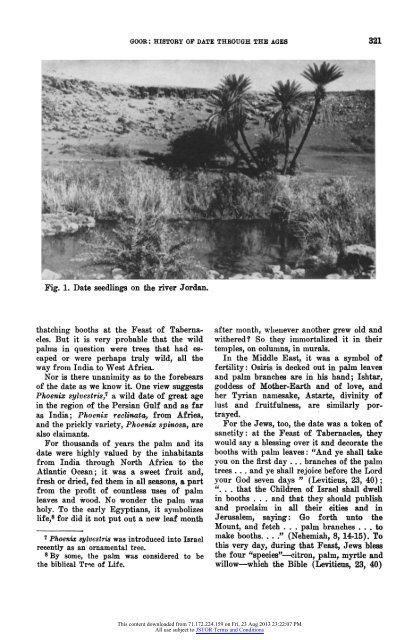The History of the Date through the Ages in the Holy Land
The History of the Date through the Ages in the Holy Land
The History of the Date through the Ages in the Holy Land
Create successful ePaper yourself
Turn your PDF publications into a flip-book with our unique Google optimized e-Paper software.
GOOR: HISTORY OF DATE THROUGH THE AGES 321<br />
* ~~~~~~~~~~~~~~~~~~~~~~~~~~~~.<br />
......... ,<br />
~~ 4~~~~14<br />
F<br />
D_<br />
Fig. 1. <strong>Date</strong> seedl<strong>in</strong>gs on <strong>the</strong> river Jordan.<br />
thatch<strong>in</strong>g booths at <strong>the</strong> Feast <strong>of</strong> Tabernacles.<br />
But it is very probable that <strong>the</strong> wild<br />
palms <strong>in</strong> question were trees that had escaped<br />
or were perhaps truly wild, all <strong>the</strong><br />
way from India to West Africa.<br />
Nor is <strong>the</strong>re unanimity as to <strong>the</strong> forebears<br />
<strong>of</strong> <strong>the</strong> date as we know it. One view suggests<br />
Phoenix sylvestris,7 a wild date <strong>of</strong> great age<br />
<strong>in</strong> <strong>the</strong> region <strong>of</strong> <strong>the</strong> Persian Gulf and as far<br />
as India; Phoenix recl<strong>in</strong>ata, from Africa,<br />
and <strong>the</strong> prickly variety, Phoenix sp<strong>in</strong>osa, are<br />
also claimants.<br />
For thousands <strong>of</strong> years <strong>the</strong> palm and its<br />
date were highly valued by <strong>the</strong> <strong>in</strong>habitants<br />
from India <strong>through</strong> North Africa to <strong>the</strong><br />
Atlantic Ocean; it was a sweet fruit and,<br />
fresh or dried, fed <strong>the</strong>m <strong>in</strong> all seasons, a part<br />
from <strong>the</strong> pr<strong>of</strong>it <strong>of</strong> countless uses <strong>of</strong> palm<br />
leaves and wood. No wonder <strong>the</strong> palm was<br />
holy. To <strong>the</strong> early Egyptians, it symbolizes<br />
life,8 for did it not put out a new leaf month<br />
7 Phoenix sylvestris was <strong>in</strong>troduced <strong>in</strong>to Israel<br />
recently as an ornamental tree.<br />
8By some, <strong>the</strong> palm was considered to be<br />
<strong>the</strong> biblical Tr-le <strong>of</strong> Life.<br />
after month, wlhe<strong>in</strong>ever ano<strong>the</strong>r grew old and<br />
wi<strong>the</strong>red! So <strong>the</strong>y immortalized it <strong>in</strong> <strong>the</strong>ir<br />
temples, on columns, <strong>in</strong> murals.<br />
In <strong>the</strong> Middle East, it was a symbol <strong>of</strong><br />
fertility: Osiris is decked out <strong>in</strong> palm leaves<br />
and palm branches axe <strong>in</strong> his hand; Ishtar,<br />
goddess <strong>of</strong> Mo<strong>the</strong>r-Earth and <strong>of</strong> love, and<br />
her Tyrian namesake, Astarte, div<strong>in</strong>ity <strong>of</strong><br />
lust and fruitfulness, are similarly portrayed.<br />
For <strong>the</strong> Jews, too, <strong>the</strong> date was a token <strong>of</strong><br />
sanctity: at <strong>the</strong> Feast <strong>of</strong> Tabernacles, <strong>the</strong>y<br />
would say a bless<strong>in</strong>g over it and decorate <strong>the</strong><br />
booths with palm leaves: "And ye shall take<br />
vou on <strong>the</strong> first day . . . branches <strong>of</strong> <strong>the</strong> palm<br />
trees . . . and ye shall rejoice before <strong>the</strong> Lord<br />
your God seven days " (Leviticus, 23, 40);<br />
". . . that <strong>the</strong> Children <strong>of</strong> Israel shall dwell<br />
<strong>in</strong> booths . . . and that <strong>the</strong>y should publish<br />
and proclaim <strong>in</strong> all <strong>the</strong>ir cities and <strong>in</strong><br />
Jerusalem, say<strong>in</strong>g: Go forth unto <strong>the</strong><br />
Mount, and fetch ... palm branches . .. to<br />
make booths...." (Nehemiah, 8, 14-15). To<br />
this very day, dur<strong>in</strong>g that Feast, Jews bless<br />
<strong>the</strong> four "species"-citron, palm, myrtle and<br />
willow-which <strong>the</strong> Bible (Leviticus, 23, 40)<br />
This content downloaded from 71.172.224.159 on Fri, 23 Aug 2013 23:22:07 PM<br />
All use subject to JSTOR Terms and Conditions
















